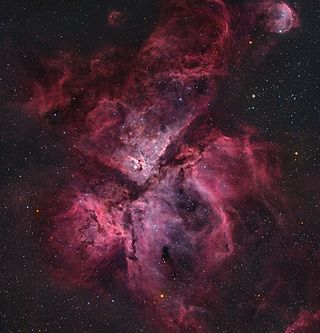
The Carina Nebula or Eta Carinae Nebula is a large, complex area of bright and dark nebulosity in the constellation Carina, located in the Carina–Sagittarius Arm of the Milky Way galaxy. The nebula is approximately 8,500 light-years (2,600 pc) from Earth.
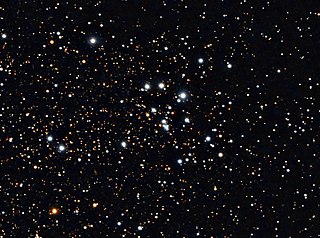
Messier 18 or M18, also designated NGC 6613, is an open cluster of stars in the constellation Sagittarius. It was discovered by Charles Messier in 1764 and included in his list of comet-like objects. From the perspective of Earth, M18 is situated between the Omega Nebula (M17) and the Small Sagittarius Star Cloud (M24).

Messier 50 or M 50, also known as NGC 2323, is an open cluster of stars in the constellation Monoceros. It was recorded by G. D. Cassini before 1711 and independently discovered by Charles Messier in 1772 while observing Biela's Comet. It is sometimes described as a 'heart-shaped' figure or a blunt arrowhead.

Messier 52 or M52, also known as NGC 7654, is an open cluster of stars in the highly northern constellation of Cassiopeia. It was discovered by Charles Messier on 1774. It can be seen from Earth under a good night sky with binoculars. The brightness of the cluster is influenced by extinction, which is stronger in the southern half. Its metallicity is somewhat below that of the Sun, and is estimated to be [Fe/H] = −0.05 ± 0.01.

NGC 381 is an open cluster of stars in the northern constellation of Cassiopeia, located at a distance of approximately 3,120 light-years from the Sun. Credit for the discovery of this cluster was given to Caroline Herschel by her brother William in 1787, although she may never have actually seen it.

NGC 1502 is a young open cluster of approximately 60 stars in the constellation Camelopardalis, discovered by William Herschel on November 3, 1787. It has a visual magnitude of 6.0 and thus is dimly visible to the naked eye. This cluster is located at a distance of approximately 3,500 light years from the Sun, at the outer edge of the Cam OB1 association of co-moving stars, and is likely part of the Orion Arm. The asterism known as Kemble's Cascade appears to "flow" into NGC 1502, but this is just a chance alignment of stars.

Westerlund 1 is a compact young super star cluster about 3.8 kpc away from Earth. It is thought to be the most massive young star cluster in the Milky Way, and was discovered by Bengt Westerlund in 1961 but remained largely unstudied for many years due to high interstellar absorption in its direction. In the future, it will probably evolve into a globular cluster.

Stephenson 2, also known as RSGC2, is a young massive open cluster belonging to the Milky Way galaxy. It was discovered in 1990 as a cluster of red supergiants in a photographic, deep infrared survey by the astronomer Charles Bruce Stephenson, after whom the cluster is named. It is located in the constellation Scutum at the distance of about 6 kpc from the Sun. It is likely situated at the intersection of the northern end of the Long Bar of the Milky Way and the inner portion of the Scutum–Centaurus Arm—one of the two major spiral arms.

NGC 371, also called Hodge 53, is an open cluster 200,000 light-years away located in the Small Magellanic Cloud in Tucana constellation.
LSS 4067, also known as CD−38°11748, is an O-type blue supergiant star located in the constellation Scorpius, very close to the galactic plane. It is part of the open cluster HM 1, although its distance is not well known; it may be anywhere between 9,500 and 12,700 light years away from the Earth. Despite being a blue supergiant, it is extremely reddened by interstellar extinction, so its apparent magnitude is brighter for longer-wavelength passbands. Without the extinction, it is estimated that LS 4067 would be 5.8 magnitudes brighter, a naked eye star with an apparent magnitude of 5.3.
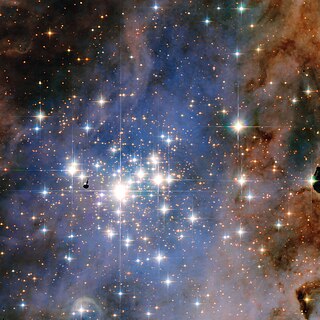
Trumpler 14 is an open cluster with a diameter of six light-years (1.8 pc), located within the inner regions of the Carina Nebula, approximately 8,980 light-years (2,753 pc) from Earth. Together with the nearby Trumpler 16, they are the main clusters of the Carina OB1 stellar association, which is the largest association in the Carina Nebula, although Trumpler 14 is not as massive or as large as Trumpler 16.
WR 142 is a Wolf-Rayet star in the constellation Cygnus, an extremely rare star on the WO oxygen sequence. It is a luminous and very hot star, highly evolved and close to exploding as a supernova. It is suspected to be a binary star with a companion orbiting about 1 AU away.

NGC 654 is an open cluster in the constellation Cassiopeia. It was discovered by William Herschel in 1787. With apparent magnitude 6.5, it can be observed by binoculars. It is located 2,5° northeast of the star Delta Cassiopeiae. In the same low power field can also be seen the open clusters NGC 663 and NGC 659. It surrounds a 7th magnitude yellowish star, an F5Ia supergiant, which is a possible member of the group.

HM 1, also known as Havlen-Moffat 1, is an open cluster located in the constellation of Scorpius, close to the galactic plane. It was first observed by R. J. Havlen and A. F. J. Moffat in 1976. HM 1 is thought to be 9,500 to 12,700 light-years away from the Earth, beyond the Carina–Sagittarius Arm. It is heavily reddened by interstellar extinction, so although it comprises mostly blue-colored stars, it appears brighter for longer-wavelength passbands. It is projected against the H II region known as RCW 121, and appears to be the source of ionization for the nearby regions RCW 122 and RCW 123.
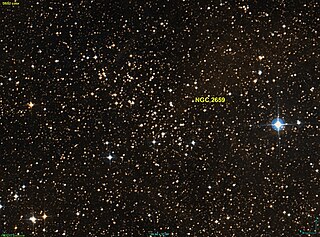
NGC 2659 is an open cluster in the constellation Vela. It was discovered by John Herschel on 3 February, 1835. It is of Trumpler class III3m. It is a young cluster, with age nearly 8 million years. The core of the cluster is 1.93 parsec across and the total radius is 3.6 pc. The total number of stars that belong to the cluster is estimated to be 1,801 ± 608 stars and the total mass 857 ± 237 M☉. Among its members, one is a Be star, with four more possible Be stars.

NGC 5617 is an open cluster in the constellation Centaurus. NGC 5617 forms a binary open cluster with Trumpler 22. It lies one degree west-northwest of Alpha Centauri.
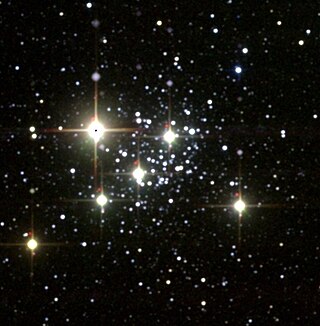
NGC 7419 is an open cluster in the constellation Cepheus. It is heavily reddened and notable for containing five red supergiants, the highest number known in any cluster until the end of the 20th century, but probably no blue supergiants.
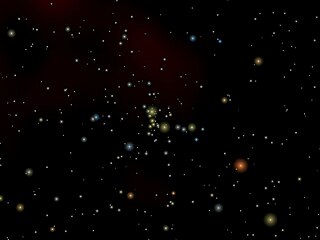
NGC 6910 is an open cluster in the constellation Cygnus. It was discovered by William Herschel on October 17, 1786. The cluster was also observed by John Herschel on September 18, 1828. It is a poor cluster with prominent central concentration and Trumpler class I2p. NGC 6910 is the core cluster of the stellar association Cygnus OB9.

Trumpler 27-1 is a red supergiant star that is a member of the massive, possible open cluster Trumpler-27, where a blue giant star, a yellow supergiant star, and two Wolf–Rayet stars are also located.

















